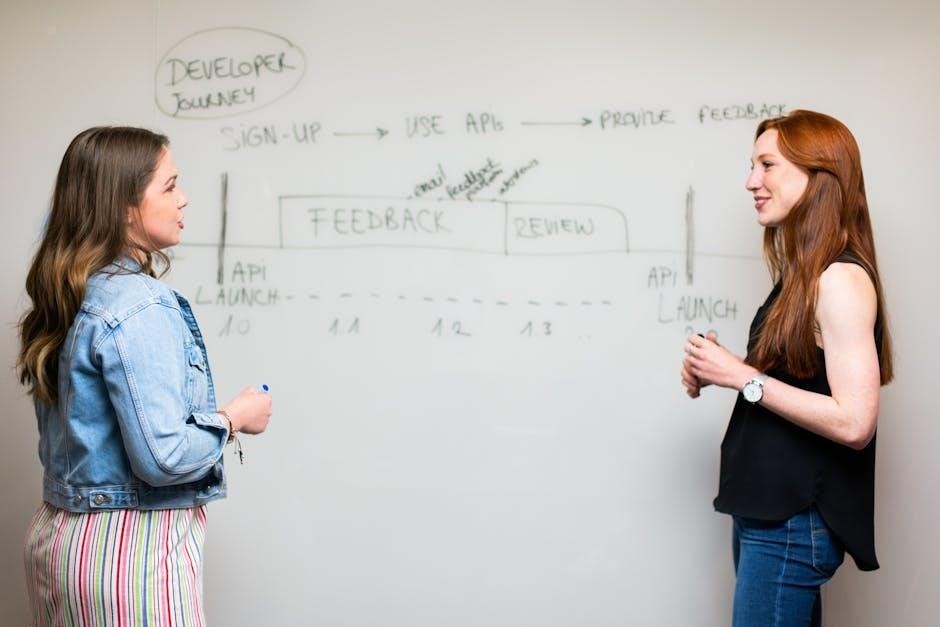Agile project management is an iterative and collaborative approach emphasizing flexibility‚ customer satisfaction‚ and delivering value. It aligns with the Agile Manifesto‚ prioritizing individuals‚ working software‚ and adaptability. The Software Project Managers Bridge to Agility by Michele Sliger offers insights for transitioning from traditional methods‚ fostering a culture of continuous improvement and team empowerment in dynamic environments.
What is Agile?
Agile is an iterative and adaptive approach to project management and software development‚ emphasizing collaboration‚ flexibility‚ and customer satisfaction. It prioritizes delivering working software in increments‚ allowing teams to respond to change and feedback quickly. The Agile Alliance defines it as a mindset shift from traditional methods‚ focusing on individuals‚ interactions‚ and adaptability over rigid processes. The Software Project Managers Bridge to Agility highlights how Agile fosters a culture of continuous improvement‚ breaking projects into smaller‚ manageable tasks. This approach enables teams to deliver value faster and align more closely with business goals‚ making it ideal for dynamic environments where requirements often evolve. By embracing Agile‚ organizations can enhance productivity‚ improve team morale‚ and better meet customer expectations in an ever-changing landscape.
The Importance of Agile in Modern Software Development
Agile methodologies are crucial in modern software development due to their ability to deliver high-quality products quickly and adapt to changing requirements. In a rapidly evolving tech landscape‚ Agile ensures that teams can respond to feedback and market demands efficiently. The Software Project Managers Bridge to Agility underscores how Agile practices foster collaboration‚ transparency‚ and continuous improvement‚ leading to better customer satisfaction. By breaking projects into smaller‚ manageable iterations‚ Agile reduces risks and enhances predictability. This approach also aligns with DevOps principles‚ streamlining development and deployment processes. As highlighted in the book‚ Agile’s emphasis on working software over comprehensive documentation ensures that deliverables meet real-world needs. Ultimately‚ Agile’s flexibility and focus on value delivery make it indispensable for organizations aiming to stay competitive in today’s fast-paced software development environment.
Challenges Faced by Traditional Project Managers
Traditional project managers often face uncertainty transitioning to Agile‚ struggling with role clarity and resistance to change. The shift from hierarchical control to facilitative collaboration can be challenging‚ requiring adaptability and trust in iterative processes‚ as highlighted in The Software Project Managers Bridge to Agility.
Understanding the Shift from Waterfall to Agile
The shift from Waterfall to Agile methodologies represents a significant change in how software projects are managed. In Waterfall‚ projects follow a linear‚ sequential approach with well-defined phases‚ while Agile emphasizes iterative development‚ flexibility‚ and continuous improvement. Transitioning requires moving from rigid plans to adaptable frameworks‚ fostering collaboration‚ and embracing uncertainty. Michele Sliger’s book‚ The Software Project Managers Bridge to Agility‚ provides guidance for project managers navigating this change‚ highlighting the importance of mindset shifts and practical strategies to integrate Agile practices effectively. This transition enables teams to respond swiftly to change‚ deliver value incrementally‚ and align more closely with customer needs‚ making it a crucial step in modern software development environments.
Common Pain Points for Project Managers in Agile
Transitioning to Agile often presents challenges for project managers‚ who may feel uncertain about their roles and responsibilities. Traditional managers struggle with losing control over detailed plans and timelines‚ as Agile emphasizes flexibility and team empowerment. They must shift from a directive approach to facilitating and enabling teams‚ which can be uncomfortable. Additionally‚ managing uncertainty and ambiguity in Agile environments requires new skills‚ such as fostering collaboration and continuous improvement. Michele Sliger’s book‚ The Software Project Managers Bridge to Agility‚ addresses these pain points by offering practical strategies for adapting to Agile principles and practices. It helps project managers understand their evolving role and how to effectively lead in dynamic‚ iterative settings‚ ensuring successful transitions and improved team performance.
Addressing Uncertainty and Resistance to Change
Transitioning to Agile often brings uncertainty and resistance‚ particularly for experienced project managers. The shift from structured‚ predictable workflows to iterative‚ adaptive processes can create anxiety. Many managers fear losing their authority and struggle to redefine their roles. The Software Project Managers Bridge to Agility provides guidance on navigating these challenges‚ emphasizing the importance of communication and collaboration. It suggests fostering trust through transparency and empowering teams to take ownership. By addressing emotional and procedural barriers‚ managers can lead their teams more effectively. The book also offers practical strategies to manage resistance‚ ensuring a smoother transition to Agile methodologies. This approach helps project managers embrace change and thrive in dynamic environments‚ ultimately enhancing team performance and project success.

The Agile Manifesto and Its Core Values
The Agile Manifesto emphasizes individuals‚ interactions‚ working software‚ customer collaboration‚ and responding to change. Its core values guide project managers in fostering collaboration‚ delivering value‚ and embracing adaptability‚ as detailed in Michele Sliger’s work.
Overview of the Agile Manifesto
The Agile Manifesto‚ created in 2001‚ outlines four core values that prioritize individuals and interactions over processes‚ working software over documentation‚ customer collaboration over contract negotiation‚ and responding to change over following a plan. It emphasizes delivering value through continuous improvement‚ flexibility‚ and customer satisfaction. The manifesto serves as the foundation for Agile methodologies‚ guiding teams to adapt to changing requirements and deliver high-quality solutions. In The Software Project Managers Bridge to Agility‚ Michele Sliger aligns these principles with practical guidance‚ helping project managers transition from traditional methods to Agile practices. The manifesto’s focus on collaboration‚ adaptability‚ and delivering working software resonates throughout the book‚ providing a clear framework for modern project management in dynamic environments.
Core Values and Principles of Agile
Agile is built on four core values: individuals and interactions‚ working software‚ customer collaboration‚ and responding to change. These values guide teams to prioritize people over processes‚ deliver functional solutions‚ engage with customers‚ and adapt to change. The 12 Agile principles emphasize iterative progress‚ delivering working software frequently‚ and continuous improvement. They advocate for self-organized teams‚ regular stakeholder collaboration‚ and reflection to improve processes. In The Software Project Managers Bridge to Agility‚ Michele Sliger highlights how these principles empower project managers to transition from command-and-control to facilitation and collaboration. By embracing Agile’s core values and principles‚ teams can achieve greater flexibility‚ transparency‚ and customer satisfaction‚ ultimately delivering value faster and adapting to market needs. This approach fosters a culture of continuous learning and improvement‚ essential for thriving in dynamic environments.

Agile Release Planning and Its Importance
Agile release planning involves high-level oversight of deliverables‚ aligning with customer needs and iterative progress. It ensures adaptability‚ enabling teams to adjust timelines and priorities while maintaining transparency and stakeholder collaboration.
How Agile Release Planning Works
Agile release planning operates through iterative cycles‚ focusing on delivering incremental value to stakeholders. It involves high-level planning‚ where the scope is defined broadly‚ and detailed tasks are refined as the project progresses. The plan remains flexible‚ allowing for adjustments based on feedback and changing requirements. Teams collaborate to establish a shared understanding of goals and priorities‚ ensuring alignment with customer needs. Continuous feedback loops enable real-time adjustments‚ fostering transparency and adaptability. The project manager facilitates communication between stakeholders and the team‚ ensuring that deliverables align with business objectives. This approach emphasizes responsiveness to change‚ enabling organizations to deliver working software in shorter cycles while maintaining clarity and focus throughout the process.
Benefits of Agile Release Planning
Agile release planning offers numerous advantages‚ including enhanced flexibility and adaptability to changing requirements. It allows teams to deliver working software in shorter cycles‚ providing faster value to customers and stakeholders. By maintaining a high-level plan‚ organizations can pivot quickly in response to feedback‚ reducing the risk of costly over-commitments. This approach fosters collaboration and alignment‚ ensuring that everyone involved shares a clear understanding of priorities and goals; Additionally‚ agile release planning promotes transparency and visibility‚ enabling stakeholders to track progress and make informed decisions. It also encourages continuous improvement‚ as teams refine their processes and deliverables based on iterative feedback. Overall‚ agile release planning helps organizations achieve greater efficiency‚ customer satisfaction‚ and responsiveness to market demands‚ making it a cornerstone of modern software development strategies.
The Role of Project Managers in Agile Environments
In agile environments‚ project managers shift from command-and-control to facilitation‚ fostering collaboration‚ removing impediments‚ and ensuring alignment with project goals. They coach teams and stakeholders‚ promote transparency‚ and drive continuous improvement‚ as detailed in Michele Sliger’s work on transitioning to agile methodologies.
Evolution of the Project Manager’s Role
The role of project managers has evolved significantly with the adoption of agile methodologies. Traditionally‚ project managers were seen as controllers‚ focusing on detailed plans and adherence to timelines. In agile environments‚ they transition to facilitators‚ enabling teams to collaborate effectively and deliver value iteratively. The shift emphasizes leadership through empowerment‚ fostering a culture of continuous improvement and adaptability. Michele Sliger’s work highlights this transformation‚ where project managers act as bridges between traditional and agile practices. They focus on removing impediments‚ aligning teams with organizational goals‚ and promoting transparency. This evolution requires project managers to embrace servant leadership‚ prioritize stakeholder engagement‚ and adapt to changing requirements. The role is no longer about command-and-control but about enabling teams to thrive in dynamic‚ iterative environments‚ ensuring alignment with agile principles and delivering customer-centric outcomes.
Key Responsibilities in Agile Teams
In agile environments‚ project managers’ responsibilities shift to fostering collaboration and enabling team success. They act as facilitators‚ ensuring clear communication and alignment with project goals. Key duties include removing impediments‚ coordinating workflows‚ and maintaining project visibility. They facilitate meetings like daily stand-ups and sprint reviews‚ promoting transparency and continuous improvement. Additionally‚ they focus on stakeholder engagement‚ ensuring customer needs are met and expectations managed. Michele Sliger emphasizes the importance of servant leadership‚ where project managers empower teams to take ownership of deliverables. They also bridge traditional and agile practices‚ integrating PMBOK guidelines with agile frameworks; Their role is to create an environment where teams can thrive‚ deliver high-quality software‚ and adapt to change effectively. By focusing on these responsibilities‚ project managers enable agile teams to achieve their full potential and deliver value incrementally. This adaptive approach ensures agility and responsiveness in dynamic software development landscapes.

Comparing Traditional and Agile Project Management
Traditional project management follows a linear‚ predictive approach‚ while Agile emphasizes flexibility and iterative delivery. Michele Sliger’s work highlights this shift‚ guiding project managers to adapt and thrive in Agile environments effectively.
Differences in Methodologies
Traditional project management often follows a rigid‚ linear approach‚ such as the Waterfall model‚ emphasizing sequential phases and predictability. In contrast‚ Agile methodologies‚ like Scrum or Kanban‚ focus on iterative progress‚ flexibility‚ and adaptability to change. While traditional methods rely on detailed documentation and predefined outcomes‚ Agile prioritizes working software‚ customer collaboration‚ and responding to change. Michele Sliger’s work highlights these differences‚ offering insights for project managers transitioning from rigid structures to more dynamic‚ collaborative environments. The shift from Waterfall to Agile requires a mindset change‚ embracing uncertainty and continuous improvement. Sliger’s approach bridges this gap‚ helping managers understand the value of iterative delivery and customer-centric practices in modern software development.
Contrasting Roles and Responsibilities
In traditional project management‚ the manager often acts as a controller‚ focusing on timelines‚ resources‚ and deliverables in a top-down manner. In contrast‚ Agile emphasizes a shift to facilitation and collaboration. The project manager evolves into a role similar to a Scrum Master‚ ensuring the team has the necessary tools and removing obstacles. Michele Sliger’s work highlights this transition‚ guiding managers from a directive approach to enabling team empowerment and iterative progress. The focus in Agile is on team collaboration and delivering value‚ differing from the rigid structures of traditional methods. This shift requires a mindset change‚ as managers learn to trust the team’s autonomy and adapt to changing requirements‚ fostering a more dynamic and responsive project environment.
The Concept of DevOps and Its Integration with Agile
DevOps combines development and operations‚ fostering collaboration and automation to streamline software delivery. Agile and DevOps share synergies‚ emphasizing iterative progress and continuous improvement. Together‚ they enhance efficiency and alignment with business goals‚ as highlighted in Michele Sliger’s insights on agility and project management evolution.
Understanding DevOps and Its Principles
DevOps is a cultural and technical movement that bridges development (Dev) and operations (Ops) teams‚ fostering collaboration and automation to improve software delivery. Its core principles include breaking down silos‚ adopting continuous integration and delivery (CI/CD) pipelines‚ and leveraging infrastructure as code. By automating repetitive tasks and enhancing feedback loops‚ DevOps accelerates time-to-market while reducing errors. Monitoring‚ logging‚ and continuous learning are integral‚ ensuring systems are observable and adaptable. DevOps also emphasizes a culture of shared responsibility and accountability‚ aligning with Agile values. While Agile focuses on iterative software development‚ DevOps extends this by streamlining deployment and maintenance. Together‚ they create a seamless workflow‚ enhancing efficiency and delivering higher-quality solutions. Michele Sliger’s work highlights how DevOps complements Agile‚ offering practical guidance for project managers transitioning to modern methodologies.
Enhancing Agility with DevOps Practices
DevOps practices significantly enhance agility by streamlining collaboration between development and operations teams. Automation of continuous integration and delivery (CI/CD) pipelines accelerates software deployment‚ reducing manual errors and enabling faster feedback loops. DevOps fosters a culture of shared responsibility‚ breaking down silos and improving communication. By integrating Agile principles with DevOps tools‚ teams achieve greater efficiency and responsiveness to change. Practices like infrastructure as code and automated testing ensure consistency and reliability‚ allowing organizations to deliver high-quality software rapidly. Michele Sliger’s work emphasizes that DevOps practices not only align with Agile values but also amplify its benefits‚ creating a cohesive environment for continuous improvement. This integration enables project managers to focus on facilitating collaboration and driving value‚ rather than managing rigid processes‚ ultimately enhancing overall agility in software development and delivery.

The Future of Agile in Software Development
The future of Agile in software development lies in embracing emerging trends like AI‚ machine learning‚ and advanced automation tools. These technologies enhance iterative processes‚ enabling faster delivery and smarter decision-making. Michele Sliger’s insights highlight the importance of continuous improvement and adaptability‚ ensuring Agile remains a cornerstone of modern software development.
Emerging Trends in Agile Methodologies
Emerging trends in Agile methodologies include the integration of AI and automation tools to enhance iterative processes. The rise of scaled Agile frameworks‚ such as SAFe and LeSS‚ supports larger enterprises in adopting Agile practices. DevOps integration is another key trend‚ fostering collaboration between development and operations for continuous delivery. Additionally‚ there is a growing emphasis on hybrid models‚ combining Agile with traditional methods to suit diverse project needs. The Software Project Managers Bridge to Agility highlights the importance of adaptability and continuous learning in navigating these trends. As organizations evolve‚ Agile methodologies are becoming more personalized to fit specific contexts‚ ensuring sustained relevance in dynamic environments. These trends underscore the necessity for project managers to embrace change and lead teams effectively in an ever-changing landscape.
Impact of Technological Advancements
Technological advancements are significantly shaping Agile methodologies‚ enabling teams to work more efficiently. Tools like Jira and Trello streamline project tracking‚ fostering transparency and collaboration. Automation in testing and deployment accelerates delivery cycles‚ reducing manual effort. AI-driven analytics provide insights into team performance and project health‚ aiding data-driven decisions. Cloud computing facilitates remote work‚ ensuring seamless communication across distributed teams. These technologies empower project managers to focus on strategic alignment and team empowerment rather than administrative tasks. The Software Project Managers Bridge to Agility emphasizes leveraging these tools to enhance Agile practices‚ ensuring teams remain adaptable in a rapidly evolving digital landscape. By embracing these advancements‚ organizations can unlock the full potential of Agile‚ driving innovation and delivering value faster than ever before.

Practical Guidance for Transitioning to Agile
Michele Sliger’s The Software Project Managers Bridge to Agility provides practical guidance for transitioning to Agile‚ helping project managers adapt by fostering collaboration and iterative practices effectively.
Steps to Successfully Transition to Agile
Transitioning to Agile requires a structured approach‚ as outlined in The Software Project Managers Bridge to Agility. Michele Sliger emphasizes starting with an Agile overview‚ understanding the shift from traditional methodologies‚ and building a bridge between PMBOK practices and Agile. The book suggests a three-part strategy: Part 1 provides an Agile overview‚ Part 2 relates PMBOK practices to Agile‚ and Part 3 guides the transition. Experienced project managers should focus on facilitation and collaboration rather than command and control. The book also highlights the importance of iterative practices‚ customer collaboration‚ and adapting to change. By following these steps‚ project managers can effectively lead their teams through the Agile transformation‚ ensuring a smooth transition and maximizing the benefits of Agile methodologies in software development.
Tools and Techniques for Agile Project Management
Agile project management relies on specific tools and techniques to enhance collaboration‚ transparency‚ and adaptability. The Software Project Managers Bridge to Agility highlights methodologies like Scrum and XP‚ emphasizing iterative development and continuous improvement. Tools such as Jira and Trello are widely used for task tracking and sprint planning‚ enabling teams to visualize workflows and monitor progress. Techniques like daily stand-ups‚ retrospectives‚ and backlog grooming foster communication and alignment. These practices help teams deliver working software incrementally while responding to change. The book also underscores the importance of collaboration tools and version control systems like Git for seamless integration. By leveraging these tools and techniques‚ project managers can effectively facilitate Agile practices‚ ensuring teams remain productive and aligned with project goals.